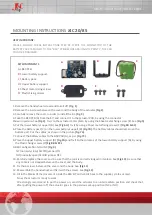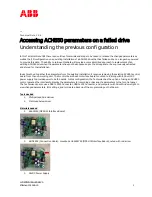
2
Reverse quadrature
8
Reversed quadrature
3
Reverse pulse & direction
12
Reversed pulse & direction
For example, to configure the main encoder for reversed quadrature, m=2, and a second encoder of pulse and
direction, n=4, the total is 6, and the command for the X axis is:
CE 6
Additional Commands for the Auxiliary Encoder
The command, DE x,y,z,w, can be used to define the position of the auxiliary encoders. For example,
DE 0,500,-30,300
sets their initial values. The positions of the auxiliary encoders may be interrogated with the command, DE?. For
example:
DE ?,,?
returns the value of the X and Z auxiliary encoders.
The auxiliary encoder position may be assigned to variables with the instructions
V1= _DEX
The command, TD XYZW, returns the current position of the auxiliary encoder.
The command, DV 1,1,1,1, configures the auxiliary encoder to be used for backlash compensation.
Backlash Compensation
There are two methods for backlash compensation using the auxiliary encoders:
1. Continuous dual loop
2. Sampled dual loop
To illustrate the problem, consider a situation in which the coupling between the motor and the load has a backlash.
To compensate for the backlash, position encoders are mounted on both the motor and the load.
The continuous dual loop combines the two feedback signals to achieve stability. This method requires careful
system tuning, and depends on the magnitude of the backlash. However, once successful, this method compensates
for the backlash continuously.
The second method, the sampled dual loop, reads the load encoder only at the end point and performs a correction.
This method is independent of the size of the backlash. However, it is effective only in point-to-point motion
systems which require position accuracy only at the endpoint.
Continuous Dual Loop - Example
Connect the load encoder to the main encoder port and connect the motor encoder to the dual encoder port. The
dual loop method splits the filter function between the two encoders. It applies the KP (proportional) and KI
(integral) terms to the position error, based on the load encoder, and applies the KD (derivative) term to the motor
encoder. This method results in a stable system.
The dual loop method is activated with the instruction DV (Dual Velocity), where
DV 1,1,1,1
activates the dual loop for the four axes and
DV 0,0,0,0
disables the dual loop.
Chapter 6 Programming Motion
•
121
DMC-40x0 User Manual
Summary of Contents for DMC-4040
Page 54: ...Chapter 3 Connecting Hardware 45 DMC 40x0 User Manual...
Page 55: ...DMC 40x0 User Manual Chapter 3 Connecting Hardware 46...
Page 56: ...Chapter 3 Connecting Hardware 47 DMC 40x0 User Manual...
Page 73: ...Figure 4 1 GalilTools DMC 40x0 User Manual Chapter 4 Software Tools and Communication 64...
Page 185: ...THIS PAGE LEFT BLANK INTENTIONALLY DMC 40x0 User Manual Chapter 7 Application Programming 176...
Page 205: ...THIS PAGE LEFT BLANK INTENTIONALLY DMC 40x0 User Manual Chapter 10 Theory of Operation 196...
Page 222: ...Step 2 Remove ICM s Appendices 213 DMC 40x0 User Manual...
Page 232: ...DMC 4080 Steps 4 and 5 Step 4 Replace ICM s Appendices 223 DMC 40x0 User Manual...
















































